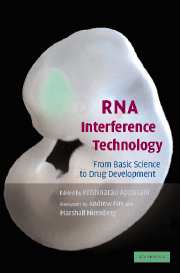Book contents
- Frontmatter
- Contents
- Foreword by Andrew Fire
- Foreword by Marshall Nirenberg
- List of Contributors
- Introduction
- Section one Basic RNAi, siRNA, microRNAs and gene-silencing mechanisms
- Section two Design, synthesis of siRNAs
- Section three Vector development and in vivo, in vitro and in ovo delivery methods
- Section four Gene silencing in model organisms
- Section five Drug target validation
- 22 Delivering siRNA in vivo for functional genomics and novel therapeutics
- 23 The role of RNA interference in drug target validation: Application to Hepatitis C
- 24 RNAi and the drug discovery process
- 25 RNA interference technology in the discovery and validation of druggable targets
- Section six Therapeutic and drug development
- Section seven High-throughput genome-wide RNAi analysis
- Index
- Plate section
- References
22 - Delivering siRNA in vivo for functional genomics and novel therapeutics
Published online by Cambridge University Press: 31 July 2009
- Frontmatter
- Contents
- Foreword by Andrew Fire
- Foreword by Marshall Nirenberg
- List of Contributors
- Introduction
- Section one Basic RNAi, siRNA, microRNAs and gene-silencing mechanisms
- Section two Design, synthesis of siRNAs
- Section three Vector development and in vivo, in vitro and in ovo delivery methods
- Section four Gene silencing in model organisms
- Section five Drug target validation
- 22 Delivering siRNA in vivo for functional genomics and novel therapeutics
- 23 The role of RNA interference in drug target validation: Application to Hepatitis C
- 24 RNAi and the drug discovery process
- 25 RNA interference technology in the discovery and validation of druggable targets
- Section six Therapeutic and drug development
- Section seven High-throughput genome-wide RNAi analysis
- Index
- Plate section
- References
Summary
Introduction
Use of siRNA in vivo to down regulate expression of a specific gene requires knowledge of target sequence accessibility, target tissue deliverability, and, for most applications, siRNA stability in both extracellular and intracellular environments (McManus and Sharp, 2002). Unlike in vitro transfection of siRNA into cells, in vivo delivery of siRNA into targeted tissue of animal models is much more complicated, involving physical, chemical and biological approaches, and in some cases their combination (Lu et al., 2003). A consequence of the fast-growing literature on using siRNA as a research tool for functional genomics is an emerging interest in siRNA as a therapeutic. Therapeutic applications, however, clearly depend upon optimized local and systemic delivery of siRNA in vivo. Therefore, delivering siRNA into targeted tissues and maintaining its activity within targeted cells and on the targeted gene sequence are the key aspects considered here, in order to fulfill the goals of both functional genomic research and therapeutic development.
Currently, using siRNA to characterize gene function and to explore therapeutic potential is spreading over almost every field in biomedical research. This phenomenon results from two basic realities: 1) siRNA is proving to be a very potent, robust, and easy to use inhibitor activated by a natural process and 2) down regulation of individual genes is a powerful tool for understanding their biological functions and may generate therapeutic benefits by reversing the pathological effects caused by over-expression of those genes.
- Type
- Chapter
- Information
- RNA Interference TechnologyFrom Basic Science to Drug Development, pp. 303 - 317Publisher: Cambridge University PressPrint publication year: 2005
References
- 1
- Cited by



